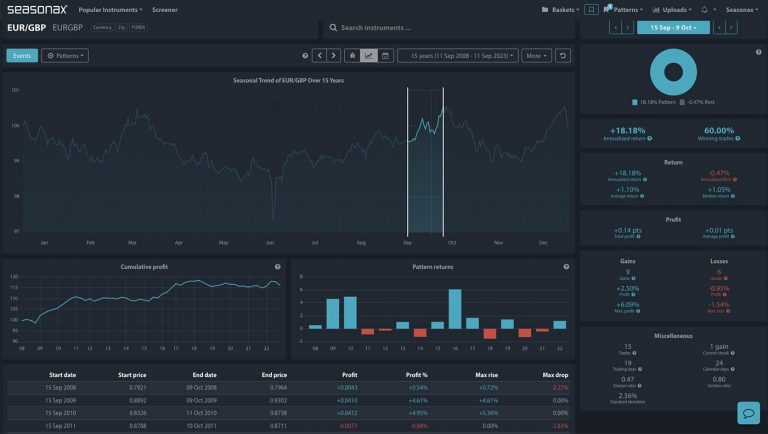Dear Investor,
The last time we have talked to you about Bitcoin was in May 2017 when we have discussed that Bitcoin too has a seasonal weakness in summer. We have shown you that you can identify a seasonal pattern in Bitcoin. It has been over a year and you might wonder why we have not addressed this topic since. There is a simple reason for this: the lack of profound historical data for cryptocurrencies in combination with an extreme volatility. Therefore, we would like to state that this market will be even more interesting for seasonal analysis once it has become less volatile. However, crypto is still one of the hottest topics in finance and we will try to use our application to see if we can find any seasonal investment opportunities and how they correspond with patterns of traditional instruments.
Bitcoin has given rise to a new generation of investors
One phenomenon of the rise of cryptocurrencies is the birth of a new generation of investors. Individuals with only marginal interest in financial markets were attracted by the disruptive approach of cryptocurrencies. Their advocates have praised a new age of financial transparency and a new democracy for the financial markets. Further accelerated by heavy promotion in social media, cryptocurrencies have experienced an unprecedented rise. While we would not like to discuss blockchain and its implications for a potential increase in financial transparency at this point, it needs to be acknowledged that Bitcoin and other cryptocurrencies are now established as real investment possibilities for real people – not just tech insiders and programming experts. Therefore, we have decided to employ our seasonal analysis for Bitcoin in order to find out whether it exhibits some of the familiar seasonal patterns.
What to do with your bitcoin?
Most probably you are aware of the first transaction paid with bitcoins. On 22 May 2010, 10,000 bitcoins were paid for two pizzas in Jacksonville, Florida. As of today, this would roughly translate to a very exclusive 64 million USD – most probably the two most expensive pizzas in history. The bespoken unprecedented rise of crypto leads to an inevitable question? Should you sell your bitcoins? Ever?
With the new generation of investors there comes a new lingo and the most prominent term with regards to holding your investment is “HODL”. The general answer in the crypto-scene two above-mentioned question is simple – “no”. You should hold and not sell your bitcoins. Ever. This has to some extent become an ideological question, which, again, we would not like to discuss at this point.
We would much rather like to focus on Bitcoin as a general financial asset, that is subject to seasonality. There are two things we need to emphasize at this point. First of all, external factors like political regulations can always have an impact on the prices and are sometimes hard to foresee. The second thing is the volatility of Bitcoin throughout the year. As an example, since 2011 the S&P 500 has on average moved in between 97 and 101.5 % of its value at the beginning of the year. In the same time-period (excluding the extreme ascent in 2010), Bitcoin has fluctuated in between 75 and 138% on average throughout the year. This suggests that trading Bitcoin demands even greater caution than trading with traditional instruments.

The S&P 500 exhibits a moderate volatility that we know from other indices and financial instruments.
Source: Seasonax Web App

Bitcoin exhibits an extreme volatility that cannot be compared to many other financial instruments.
Source: Seasonax
Bitcoin rally starts in the middle of October
For most financial assets, and we have talked about this in previous Seasonal Insights, the months of September and October represent a traditional decline in prices. When examining Bitcoin, we can identify the same pattern. As you can easily observe above, the summer low we have talked to you about in May 2017 continues right until the middle of October.
The interesting time, for us as investors, starts after this decline turns around. Beginning in October, Bitcoin experiences a traditional rally that continues right up until December. We have excluded the year of 2010 with its extreme values, but we still find staggering numbers.
During the time-period Bitcoin showed winning trades in all years but 2014 (2010 was excluded but has in fact shown the sharpest increase in prices). The annualized return is at a breath-taking 4,240%. From an investment perspective, this is as good as an opportunity gets.

Bitcoin shows incredible increases in prices.
Source: Seasonax
Nevertheless, there are a couple of things you should consider. Many people see their bitcoins as an investment opportunity rather than subject to trading. If you chose this strategy, then you can disregard this issue’s insights and hold your bitcoins long-term.
You might also still be skeptical about crypto in general and would like to refrain from buying and selling it at all. Some very prominent experts share this opinion, for instance JP Morgan CEO Jamie Dimon who called Bitcoin a “fraud”. Or Ray Dalio, founder of Bridgewater Associates who considers Bitcoin to be a “bubble”.
However, if you consider it as a financial instrument that yields above-average returns you might want to take one step back and not get carried away by the skyrocketing returns but employ statistically robust methods of analysis. We believe in the power of seasonality and are convinced that you can use its basic mechanisms to identify investment opportunities – even in Bitcoin.
While we advise you to show even greater caution when trading crypto, our seasonal analysis has shown that there is a potential upcoming trading opportunity.
There are no guarantees in the markets (certainly not with crypto) but you can let the probabilities work in your favor!


